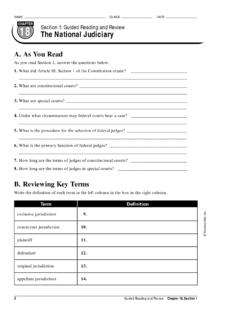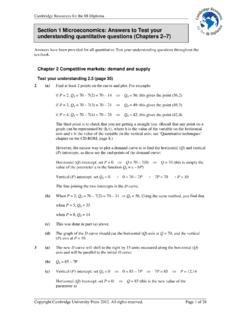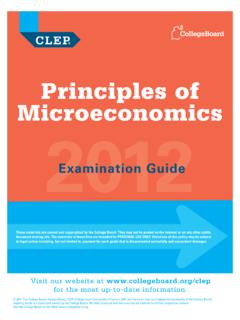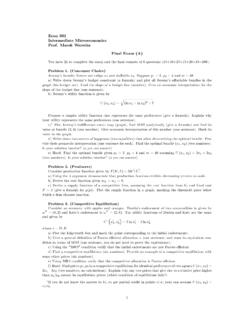Transcription of AP MICROECONOMICS PRACTICE TEST: ANSWER KEY
1 I PART FIVE: PRACTICE TESTS 310 I AP MICROECONOMICS PRACTICE TEST AP MICROECONOMICS PRACTICE TEST: ANSWER KEY 16. 2. E 17. 18. 19. 5. A 20. 2 I. 7. C 22. 8. C 23. 9. C 24. 10. 0 25. II. B 26. 12. 0 27. 13. B 28. 14. C 29. 15. C 30. A A E C 0 0 0 B 0 C 0 C C E B 3I. 32. 33. 34. 35. 36. 37. 38. 39. 40. 4 I. 42. 43. 44. 45. 0 46. A E 47. C 0 48. 0 0 49. B E 50. C E 5I. 0 C 52. E B 53. E A 54. C A 55. A C 56. 0 B 57. A 0 58. E E 59. C B GO. B PART FIVE: PRACTICE TESTS 312 AP MICROECONOMICS PRACTICE TEST answers AND EXPLANATIONS SECTION I 1.
2 C Economists use marginal analysis to model the benefits and costs of incremental choices, which constitute the majority of choices. Choice (C) is therefore correct. 2. E Choice (E) is correct because if the supply of lawyers increases, lawyers' salaries will fall only if the supply curve for lawyers shifts to the right (increases) more than the demand curve for lawyers does. Choice (A) does not consider demand as a factor. Choice (B) is incorrect because the supply of new lawyers will move the supply curve as noted.
3 Choice (C) considers demand but not sup ply. Choice (0 ) states the opposite of the correct ANSWER ; 3. D The correct choice (0 ) states that the marginal revenue product (MRP) of capital is defined as the additional revenue a firm earns when it employs an additional unit ofcapital , all other th ings being equal. MRP considers both the additional product that the new capital produces and the price of the product made. This makes (A) incorrect. Choice (B) is incorrect because the cost of the additional unit of capital is not used in the calculation of MRP.
4 Choice (C ) is incorrect because profitis determined by taking the revenue earned and su btracting the costs. C ho ice (E) does not refer to the ad d itio nal unit of capital used. 4. C If consumers exhibit a dem and for an output, a demand for inputs arises. Thus, an increase in demand for tortilla chips (out put ) generates an increase in demand for co rn (an input). Choice (C ) defines this derived demand. Cho ices (A) and (B) note that su pply sh ifts, but a change in the demand for ch ips will not cause a sh ift in supply.
5 Choice (0 ) is incorrect, being the opposite of the correct choice. C ho ice (E) is incorrect because a higher demand for chips will increase the demand for corn, resulting in a higher price for corn. 5. A Public goods are not exclusive, and they are not rival. Those goods that exhibit nonexclusion are those for which it is too costly to develop a means of preventing those who refuse to pay from enjoying the benefits. Choice (B) is another characteristic of public goods but not the term used to define this issue.
6 Choice (C) is not an economic term. Choice (0) is incorrect because it defines the condition of those people who benefit as third parties from a market transaction that others have entered. Choice (E) is also incorrect because it defines a market failure where third parties are harmed by a market transactio n that others have entered. 6. C For a firm selling in a perfectly competitive market, the marginal revenue product (MRP) is equal to the marginal physical product (MPP) times the market price.
7 Here, 5 units per labor input times $10 per unit ofoutput equals $50. Choice (C) is the correct ANSWER , while the other choices do not follow the formula, MRP =MPP X P. 7. C C ho ice (C) expresses the view that the demand curve is downward sloping because of the law of diminishing marginal utility. After some point, as oneco nsumes more ofa good orservice, the marginal, or extra, utility will decline. Choice (A) is ' incorrect because total utility can no t fall below the marginal utility. Choice (B) is also incorrect because even if this statement is true , it does not define why the demand curve is downward sloping.
8 Choice (0) is incorrect because time is not related to marginal utility. Choice (E) is incorrect because although the incomeandsu bstitu tio n effectsare reasons why the demand curve is downward slo ping, they do not work together to offset each other. 313 8. C Choice (C) is correct because price elasticity of demand measures how consumer demand chan ges in response to a change in price. Choice (A) is incorrect because transaction costs are the opportunity costs in making a transaction. Choice (B) is incorrect because demand does not involve supply ideas like cost.
9 Choice (0) is incorrect because price elasticity does not factor in taxes, and (E) is incorrect because it is a supply idea, not a demand notion. 9. C Inelastic demand occurs when the percentage change in quantity demanded is less than the percentage change in price. Total revenue is the price of the product times the quantity demanded. Choice (C) correctly states that a price increase will yield higher total revenues only if the demand curve is inelastic. Choices (A) and (B) are other measures of elasticity, but (A) would mean that total revenues would fall, and (B) would mean that total revenues would be constant.
10 Choices (0) and (E) are incorrect because perftct/y means that either no change or infinite change would result. 10. D A government imposes a price ceiling when it feelsthatthe price ofa goodor service is too high. Choice (0) correctly states that the ceiling price is set below the market equilibrium, making it possible for more consumers to afford to buy the good or service. Choice (A) is incorrect because a price floor will create an excess amount, or surplus. Choice (B) is incorrect because although a price ceiling creates a shortage, it is not the definition of a price ceiling.










